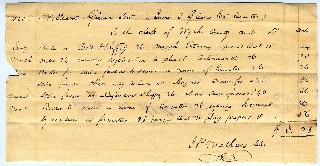- Welcome
- Family History
- Letters & Diaries
- Folder: 1820 - 1839
- Court costs for writ of scire facias vs Bell and Sheffey
 Court costs for writ of scire facias vs Bell and Sheffey
Court costs for writ of scire facias vs Bell and Sheffey
- » Date: 1820
- » Subject: Court costs for writ of scire facias vs Bell and Sheffey
- » Written By: J. P. Mathews, Clerk of Court
- » Addressed To: William Gleaves Sr
- » Transcriber: Lois Gleaves
- » File # 455
Page 1
|
1820 |
William Gleaves Senr. (James Gleaves, Esq. Executor) |
|
|
|
|
To the Clerk of Wythe County Court |
Dr |
cents |
|
Jany |
Rule vs Bell and Sheffey 26. March entering special bail 18 |
|
44 |
|
March |
Order 26 entering replication to plea 18 continuance 26 |
|
70 |
|
[J]une |
Order for scire facias to review in name of Executor 26 |
|
26 |
|
|
scire facias & recording return 40. August order for alias |
|
40 |
|
August |
scire facias vs Defendant Sheffy 26 alias scire facias 40 |
|
66 |
|
Novr |
Order to revive in name of Executor 26, entering Judgement |
|
26 |
|
|
by nonsum in formatives 18, taxing costs 20, filing papers 18 |
|
56 |
|
|
(Total) |
$3. |
28 |
|
|
J. P. Mathews, C.C. |
|
|
Transcriber Notes
From http://law.jrank.org/pages/10038/Scire-Facias.html
Scire Facias: [Latin, Made known.] A judicial writ requiring a defendant to appear in court and prove why an existing judgment should not be executed against him or her.
In the law, scire facias is a judicial writ that is brought in a case that has already been before a court. Writ is the old English term for a judicial order. Some states still use the term. A scire facias writ commands the person against whom it is brought to appear before the court and show why the record should not be resolved in favor of the party who brought the writ.
The scire facias writ originated in England, and its use was adopted by the American colonists.
In modern practice, the writ of scire facias is used in the enforcement and collection of judgments. When a plaintiff in a civil case obtains a money judgment against a defendant, the court order to pay the judgment may expire after a certain number of years if the judgment remains unpaid. State and federal laws allow the plaintiff to make a motion to the court before the time period expires to continue the effect of the court's order. If the plaintiff fails to make such a motion, he may file a writ of scire facias to revive the judgment. The defendant would then have to appear before the court and explain why the judgment should not be revived. If the defendant has already paid the plaintiff, or if the defendant has evidence that he owes the plaintiff nothing, the defendant may present evidence and shift the burden of proof to the plaintiff.
If the defendant is unable to defend his failure to pay the judgment, the court will order execution of the judgment. The court may order the defendant to submit to a financial status examination, to sell property to satisfy the judgment, or to take other measures to satisfy the judgment.


